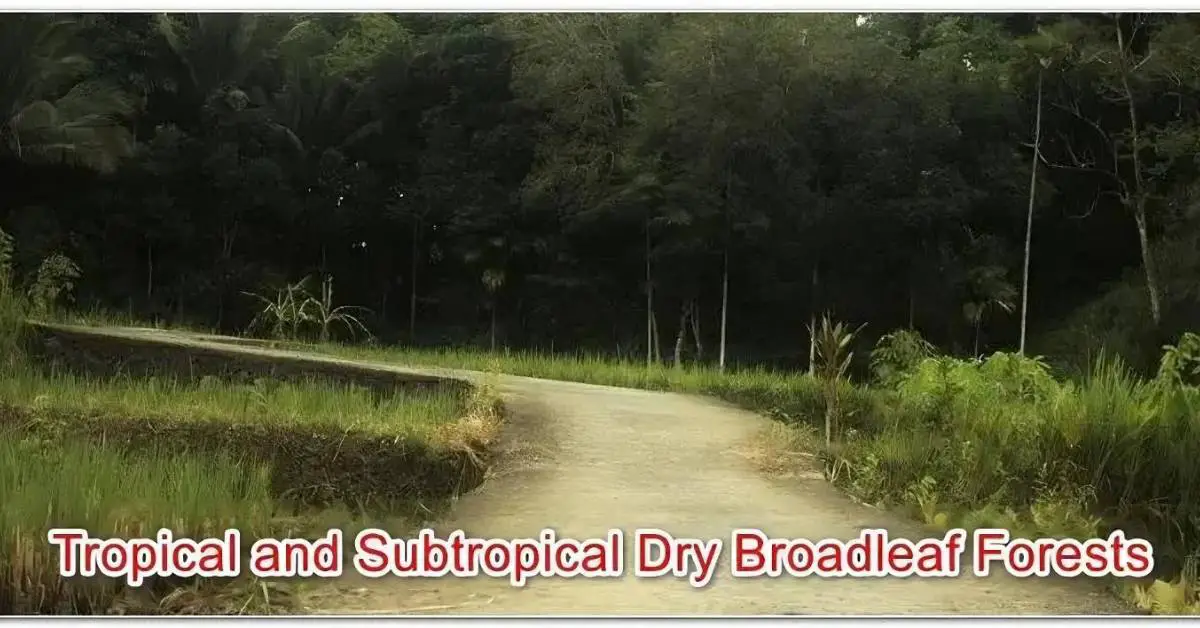Tropical and Subtropical Dry Broadleaf Forests
Tropical and subtropical forests grow in areas with warm climates. These are found in regions that receive lower rainfall (several hundred centimetres) throughout the year. They face drought because of dry seasons, which last up to many months. The tropical and subtropical dry broadleaf forests deviate with geographic location.
Deciduous trees are found profusely. These trees possess characteristics that help them face the dry period. Leaves of deciduous trees are waxy to prevent water loss from evaporation, and they store water in their tissues. Trees cast off their leaves during the dry season to evade moisture deprivation.

Tropical and Subtropical Dry Broadleaf Forests
Tropical and subtropical dry broadleaf forests are not dense. Thus, they allow the sunlight to reach the ground, which helps grow thick bushes. They are less diverse than the rainforest. Parrots, monkeys, large cats, birds that dwell on the ground, rodents, and others are found in tropical and subtropical dry forests. Many of these animals show adaptability to dry and challenging periods.
The tropical and subtropical dry broadleaf forests are found in Lesser Sundas, Southern Mexico, South-East Africa, Indo-China, Madagascar, Central Brazil, New Caledonia, East Bolivia, North Andes valley, the Caribbean, and Ecuador and Peru coast.
Southern Mexico and Bolivian Lowlands are home to the World’s most diverse seasonal/dry forest. South America’s tropical and subtropical dry forests and the North-West Pacific coast are the most isolated. Thus, they are home to a variety of unique species.
Diverse endemics are found in the dry forests of Maputoland-Pondoland in South-Eastern Africa. Tropical forests found in Indo-China and Central India have much notable vertebrate fauna. Dry broadleaf forests of New Caledonia and Madagascar are peculiar and home to a variety of taxa at a high taxonomy level.
Definition of Tropical Dry Forest
The tropical Dry Forest is a forest that grows in an area with seasonal rainfall and a warm climate. Deciduous trees are found abundantly in the Tropical Dry Forest. Trees cast off their leaves during the dry season to evade moisture deprivation. The leaves of these plants have a waxy coating to prevent water loss. They use their tissues to store water for the dry period.
What is a Dry Forest?
Dry forests result from low rainfall. These forests grow in areas with no foreseeable monsoon season, and rain occurs at any time, either in small or huge quantities. Trees in these forests are resistant to drought with unique adaptation characteristics. The dry forest is home to trees like Juniper, Olive, Oak, Pine, Acacia, etc.
Tropical Seasonal Forest Location
Tropical Seasonal or Dry Forest grows in seasonal climates (alteration between wet and dry seasons). This wildlife and forests are located towards the South and North of the Equatorial Rainforest and Subtropical Desert belts. They occur in two bands: between 10 degrees North and 20 degrees North and between 10 degrees and 20 degrees South Latitudes.
The tropical seasonal forests are abundant in Indian forests, West Africa, South-East Asia, Northern Australia, West Indies, Paraguay, Southern parts of Mexico, etc. Southern Mexico and Bolivian Lowlands are home to the World’s most diverse seasonal/ dry forest.
Biodiversity pattern
Dry forest abundance in a variety of species than the moist forest. These species show high restrictions in many regions. The most abundant species of plants in the dry forests are the tropical dry forests. Though the dry forest has high alpha and beta diversity, it’s still less than the moist forest.
Minimum requirements
- The dry forest species need continual riverine forests and a source of water.
- Dry forest abundance in predators and vertebrates. Thus, a large natural area is required for their maintenance.
- A forest fire may occur at any time. Therefore, a large block of undamaged forest is necessary to absorb damages from the periodic fire.
- Extensive dry forest areas are required to protect the subtle species from hunting.
Sensitivity to disturbance
Deforestation and burning affect the dry forest severely. The natural community of dry forests suffers alteration because of exotic species and overgrazing. Because of continuous and severe degradation, the restoration of dry forests becomes taxing.
Articles:-
- First National Park of India Jim Corbett
- Valki Machan Tour | Kolkata to Valkimachan Bardhaman West Bengal
- Sultanpur National Park Gurgaon
- Gurgaon Sultanpur Bird Sanctuary timings, entry fee
- Where is Betla National Park? Address, Timings, Entry Fee
- Alipore Zoological Garden Kolkata | Chiriakhana entry, timings, animals
- Bhadra Wildlife Sanctuary and Tiger Reserve in India
- Chintamani Kar bird sanctuary
- Ballavpur Wildlife Sanctuary | Deer Park Bolpur West Bengal
- Tropical and Subtropical Dry Broadleaf Forests
- Gir National Park in Gujarat is famous for which animal?
- How to reach Ranthambore National Park
- Turahalli Forest cycling trails, trekking, hiking, bike ride